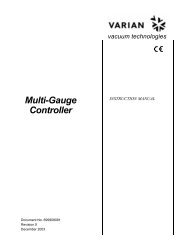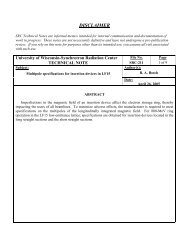SRC Users' Meeting - Synchrotron Radiation Center - University of ...
SRC Users' Meeting - Synchrotron Radiation Center - University of ...
SRC Users' Meeting - Synchrotron Radiation Center - University of ...
You also want an ePaper? Increase the reach of your titles
YUMPU automatically turns print PDFs into web optimized ePapers that Google loves.
ACCELERATOR DEVELOPMENTS<br />
Ken Jacobs<br />
<strong>Synchrotron</strong> <strong>Radiation</strong> <strong>Center</strong>, <strong>University</strong> <strong>of</strong> Wisconsin - Madison<br />
3731 Schneider Drive, Stoughton, WI 53589-3097<br />
Work has continued on a variety <strong>of</strong> accelerator developments at the <strong>SRC</strong> over the<br />
past year. The low emittance operating mode “LF15” is now routinely run for all<br />
800 MeV beams. This gives a factor <strong>of</strong> three reduction in horizontal beam size, with<br />
unchanged vertical beam size and beam lifetime. The exception to routine LF15 running<br />
is when vacuum work is done in the ring, after which Base Lattice is run for the first few<br />
weeks.<br />
LF15 cannot be run at 1 GeV due to power supply, cabling, and magnet<br />
limitations. For reduced emittance at 1 GeV, an alternate lattice with emittance between<br />
LF15 and Base Lattice has been designed. Operation will require upgraded cables on<br />
some <strong>of</strong> the quadrupoles, and this is presently being pursued. However, LF15 can be run<br />
at 950 MeV, requiring only the cable upgrades. Tests <strong>of</strong> 950 MeV LF15 have been<br />
encouraging. We are also investigating other low emittance 950 MeV lattices.<br />
We continued to make improvements made in beam stability. An additional<br />
feedback loop was installed in the main RF system to reduce coherent synchrotron<br />
oscillations <strong>of</strong> the beam. This, combined with a general reduction <strong>of</strong> 60 Hz harmonics on<br />
the beam, has reduced noise levels on the infrared beamlines so that they can now be<br />
used when running low emittance beam. Undulator compensation has progressed to the<br />
point that U1 and U3 can now be scanned over their full ranges in LF15. Compensation<br />
work is continuing with U2, and in Base Lattice.<br />
In an effort to improve beam lifetime, we are continuing studies to more fully<br />
understand beam loss mechanisms. To increase lifetime, it may be necessary to open up<br />
some limiting apertures in the ring.<br />
Other projects completed over the past year include upgrading the accelerator<br />
control system CPUs, coating the injection kicker ceramics to reduce wakefields and<br />
radiated RF, and installation <strong>of</strong> a modern scripting language on the control system.<br />
Scripts are used to simplify accelerator operations, implement control algorithms to<br />
improve beam stability, and perform experiments during accelerator development<br />
periods.
















